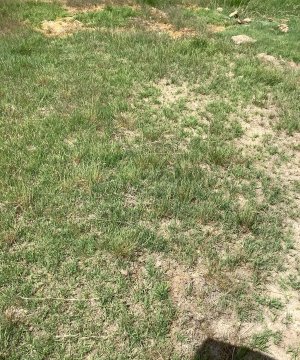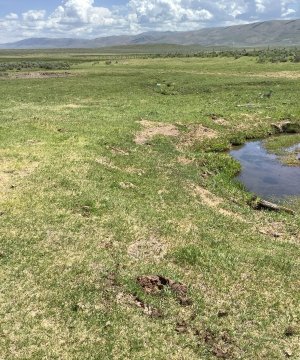Saline Subirrigated Bear River Valley 10-14" P.Z.
Scenario model
Current ecosystem state
Select a state
Management practices/drivers
Select a transition or restoration pathway
- Transition T1A More details
- Transition T1B More details
- Restoration pathway R2A More details
- Transition T2A More details
- Restoration pathway R3A More details
- Restoration pathway R3B More details
-
No transition or restoration pathway between the selected states has been described
Target ecosystem state
Select a state
Description
The Reference state of this ecological site is dominated by a mix of native grasses and forbs, many species being salt-tolerant. The plant communities in the Reference state evolved with grazing by large herbivores and are suited for managed grazing by domestic livestock.
The primary salt-tolerant grass species found at this site in the Reference state include alkali sacaton (Sporobolus airoides), Nutall alkaligrass (Puccinellia nuttalliana), and saltgrass (Distichlis spicata). Other major grass, sedge, and rush species include needlelfeaf sedge (Carex duriuscula), western wheatgrass (Pascopyrum smithii) and slender wheatgrass (Elymus trachycaulus), Sandberg bluegrass (Poa secunda), arctic rush (Juncus arcticus), and basin wildrye (Leymus cinereus).
Shrub composition and cover is generally limited at this site but can include greasewood (Sarcobatus vermiculatus) and rubber rabbitbrush (Ericameria nauseous). Forb cover can include goldenweed (Pyrrocoma sp.), arrowgrass (Triglochin sp.), and other perennial and annual forbs. Each plant community within the reference state differs in percent composition and canopy cover.
Three important processes occur in the Reference state and result in community changes: 1) Changes to the hydrologic regime; 2) Disturbances such as herbivory and drought; and 3) Specific salinity concentration within plant rooting depth.
Characteristics and indicators
Community occurrence as well as shifts between communities are a result of localized variation in the hydrology, small-scale disturbance, or localized soil salinity levels. Sites with the water table closer to the surface or inundated for longer periods of time are more likely to result in the Sedge/Grass community. Sites that have higher salinity concentrations are more likely to result in the Alkali Sacaton/Basin Wildrye community.
Resilience management
Resilience in the Reference state of this ecological site is strongly tied to hydrologic function. When the hydrologic system is functioning properly, resilience is high. If changes in the hydrologic regime occur due to natural or anthropogenic disturbances. Resilience decreases.
Submodel
Description
The Grazing Resistant state is a result of continuous grazing by domestic livestock at high intensity. The grazing-related disturbances lead to a decrease in diversity, promoting species that are able to tolerate heavy grazing. Dominant salt-tolerant species include scratchgrass (Muhlenbergia asperifolia) and Sandberg bluegrass. Other dominant plants include arctic rush, and western wheatgrass.
Hydrology is functioning in this state, but the biotic integrity is at risk due to a lack of species diversity. Lack of diversity as well as grazing pressure can also lead to an increase in invasive species establishment.
Characteristics and indicators
This site is indicated by a lack of overall diversity in the plant composition as well as an increased overstory in grazing-tolerant plants. Continued heavy grazing makes these characteristics more pronounced and can eventually result in transition to the disturbed community if not managed.
Resilience management
This state is moderately resilient. Resilience is gained by the shallow depth of a seasonal water table, which can moderate the impact of drought conditions. However, the lack of diversity makes this site more susceptible to the impacts of disturbances such as insect damage, disease, herbivory, and fire.
Submodel
Description
The Disturbed state is a result of natural or anthropogenic disturbances to the ecological site. The two primary disturbances that impact this site are plowing and haying practices, followed by abandonment and activities that alter the natural hydrologic regime. These disturbances lead to the introduction and establishment of non-native species. Following the disturbance, the common grass species that establish are meadow foxtail (Alopecurus spp.), foxtail barley (Hordeum jubatum), and quackgrass (Elymus repens). Common forbs include Canada thistle (Cirsium arvense) and povertyweed (Iva axillaris).
Characteristics and indicators
This state is dependent on disturbances that displace native vegetation and create opportunities for invasive species establishment. The severity and frequency of the disturbance can often dictate the level of establishment of invasive species. Alteration of hydrology that cannot be restored has the potential to shift create a shift to a new ecological site.
Resilience management
This site has low resilience and biotic integrity due to the composition of non-native plant species. Mechanical treatments followed by reseeding and prescribed grazing will aid in the transition back to the Reference state. For restoration to be successful, the historic hydrologic regime must be functional with reliable seasonal water table levels. Regardless of intervention and restoration techniques, some invasive species such as foxtail barely and meadow foxtail may continue to persist to some degree.
Submodel
Mechanism
The transition from the Reference state to the Grazing Resistant state is driven by grazing-related disturbances. Continuous grazing or extended periods of intense grazing can reduce the presence of grazing-intolerant species, decrease diversity, and increase canopy cover of increaser species.
If grazing practices continue and mitigation measures are not taken, this can eventually cause a transition to the Disturbed state.
Constraints to recovery
The primary constraint to recovery is improper grazing management. Resting periods and decreased grazing intensity will be needed for recovery and restoration towards the Reference state.
Context dependence
The transition from the Reference state to the Grazing Resistant state can be affected by seasonal weather patterns and other disturbances such as drought or fire.
Mechanism
The transition from the Reference state to the Disturbed state is a result of both natural and anthropogenic disturbances. High-severity disturbances and those outside of the natural disturbance regime are more likely to initiate a transition from the Reference state. The primary disturbances impacting this ecological site resulting in transition include agricultural plowing and abandonment, drought, fire, and alteration of the hydrologic regime.
Constraints to recovery
Constraints to recovery vary based on disturbance history. Non-functioning hydrology can severely limit restoration. Continued disturbances, even low in severity, as well as potential invasive species establishment can also constrain recovery.
Context dependence
Restoration is affected by seasonal weather patterns, current disturbance regimes, and the severity of past disturbances. If the site has a significant canopy cover and composition of invasive species, this will also impact management decisions and the likelihood of restoration success.
Mechanism
Restoration from the Grazing Resistant state to the Reference state requires a change in grazing practices. Less intensive grazing with periods of rest can facilitate natural return to the Reference state. Removal of invasive species and seeding may be required depending on conditions.
Context dependence
Restoration success is dependent on successful grazing plans and adaptive management. Restoration time can be decreased through seeding and rest from grazing. Other disturbances such as drought, fire, or alteration of the hydrologic function can slow restoration or initiate transition to the Disturbed state.
Mechanism
The transition from the Grazing Resistant state to the Disturbed state is a mechanism of severe or repeated disturbance, often outside the historic disturbance regime for the ecological site. The most common disturbances to initiate the transition are continuous intensive grazing, fire, drought, and alteration of the hydrologic regime. These disturbances result in the removal of grazing-resistant species, which allows for the establishment of fast-establishing invasive species.
Constraints to recovery
Restoration to the Grazing Resistant state is dependent on severity of initial disturbance and absence of disturbances during recovery time. If the hydrologic regime has been altered, function will need to be returned before successful restoration can occur.
Context dependence
Restoration likelihood is affected by seasonal weather patterns, current disturbance regimes, and severity of past disturbances. If the site has a significant canopy cover and composition of invasive species, this will also impact management decisions and the likelihood of restoration success.
Mechanism
Restoration from the Disturbed state to the Reference state requires removal of invasive species and restoration of the hydrologic regime to historic depth and seasonal duration if it has been altered.
Removal of invasive species can be achieved through mechanical and chemical treatments, targeted grazing, or a combination of the three. Success of invasive species removal is improved if planting or seeding of native species is completed afterward.
Context dependence
Restoration success is dependent on ability to restore hydrologic function a level of invasive species establishment. Time without further disturbance also increases restoration success.
Mechanism
Restoration from the Disturbed state to the Grazing Resistant state requires removal of invasive species and restoration of the hydrologic regime to historic depth and seasonal duration if it has been altered.
Removal of invasive species can be achieved through mechanical and chemical treatments, targeted grazing, or a combination of the three. Success of invasive species removal is improved if planting or seeding of native species is completed afterward.
Context dependence
Restoration success is dependent on the ability to restore hydrologic function a level of invasive species establishment. Time without further disturbance also increases restoration success.
Model keys
Briefcase
Add ecological sites and Major Land Resource Areas to your briefcase by clicking on the briefcase (![]() ) icon wherever it occurs. Drag and drop items to reorder. Cookies are used to store briefcase items between browsing sessions. Because of this, the number of items that can be added to your briefcase is limited, and briefcase items added on one device and browser cannot be accessed from another device or browser. Users who do not wish to place cookies on their devices should not use the briefcase tool. Briefcase cookies serve no other purpose than described here and are deleted whenever browsing history is cleared.
) icon wherever it occurs. Drag and drop items to reorder. Cookies are used to store briefcase items between browsing sessions. Because of this, the number of items that can be added to your briefcase is limited, and briefcase items added on one device and browser cannot be accessed from another device or browser. Users who do not wish to place cookies on their devices should not use the briefcase tool. Briefcase cookies serve no other purpose than described here and are deleted whenever browsing history is cleared.
Ecological sites
Major Land Resource Areas
The Ecosystem Dynamics Interpretive Tool is an information system framework developed by the USDA-ARS Jornada Experimental Range, USDA Natural Resources Conservation Service, and New Mexico State University.


![IMG_0076[1]](https://edit.jornada.nmsu.edu/uploads/large/zp/re/1738863919_617546.jpg)
